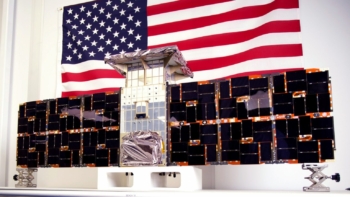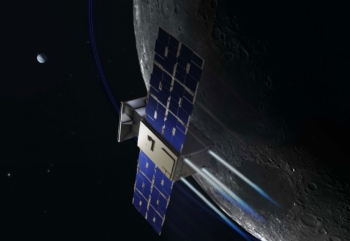NASA’s Cislunar Autonomous Positioning System Technology Operations and Navigation Experiment (CAPSTONE) is healthy and doing well.
The mini-probe suffered an anomaly during commissioning activities. The operations team began actively working the issue with the NASA Deep Space Network and identified a path forward.
Anomaly details
According to NASA in detailing the anomaly: “During commissioning of CAPSTONE, the Deep Space Network team noted inconsistent ranging data. While investigating this, the spacecraft operations team attempted to access diagnostic data on the spacecraft’s radio and sent an improperly formatted command that made the radio inoperable. The spacecraft fault detection system should have immediately rebooted the radio but did not because of a fault in the spacecraft flight software.”

Designed and built by Terran Orbital, CAPSTONE will support NASA’s Artemis program in reducing the risk for future Moon bound spacecraft.
Credit: Terran Orbital
“CAPSTONE’s autonomous flight software system eventually cleared the fault and brought the spacecraft back into communication with the ground, allowing the team to implement recovery procedures and begin commanding the spacecraft again,” the NASA statement explains.
Review of data
On Saturday morning, a trajectory correction maneuver (TCM) was rescheduled.
The CAPSTONE mission team rescheduled the TCM “to review additional data and perform additional analysis to support modeling of the spacecraft performance during maneuvers,” according to Advanced Space, owner and operator of outbound probe.

CAPSTONE team members install solar panels onto the Cislunar Autonomous Positioning System Technology Operations and Navigation Experiment – at Tyvak Nano-Satellite Systems Inc. in Irvine, California.
Credits: NASA/Dominic Hart
The rescheduled plan does not have any significant impact on the size of the planned correction maneuver which was part of the TCM-1 executed two days prior.
The spacecraft is healthy, communicating with NASA’s Deep Space Network (DSN) and in a nominal state.
Scheduled TCMs
TCM1 had three scheduled maneuvers:TCM1a, TCM1b and TCM1c.
According to Advanced Space, the purpose of these scheduled TCM1 series is:
— Cleaning up the launch injection deviations from the Lunar Photon vehicle
— Commissioning the thrusters which calibrates the propulsion system
TCM1a completed approximately 90% of the objectives of the TCM. With the healthy state of the spacecraft TCM1b did not need to be performed.
“In the typical course of spacecraft commissioning activity, schedules often are adjusted. The mission team continues to work around the clock on flight dynamics analysis, trajectory design, spacecraft commanding, communications and health check activities and looks forward to the next needed maneuver,” Advanced Space said in a statement.
“Overall, CAPSTONE is in a nominal state, healthy and still on schedule to arrival to the Moon in four months on November 13th.”
The destination for this microwave oven-size CubeSat is a near rectilinear halo orbit (NRHO), the orbit of choice planned for Gateway, the multipurpose outpost for long-term lunar missions as part of NASA’s Artemis program.
The Gateway in lunar orbit is where astronauts will transfer between the Orion piloted spacecraft and the lander on regular Artemis missions.



